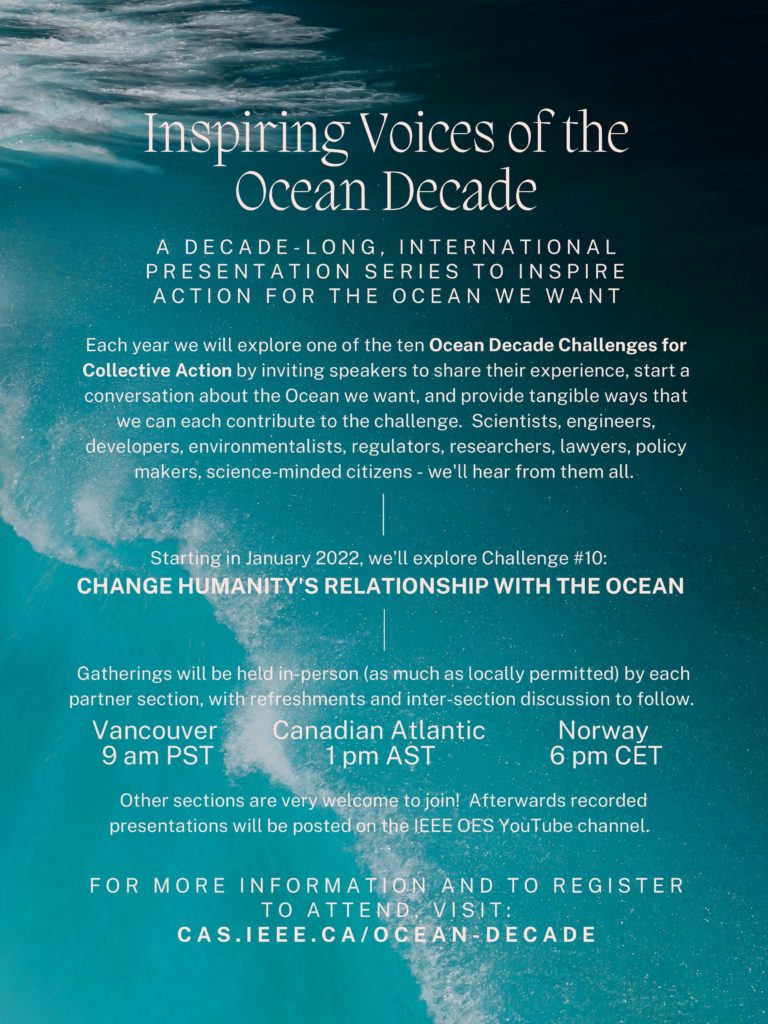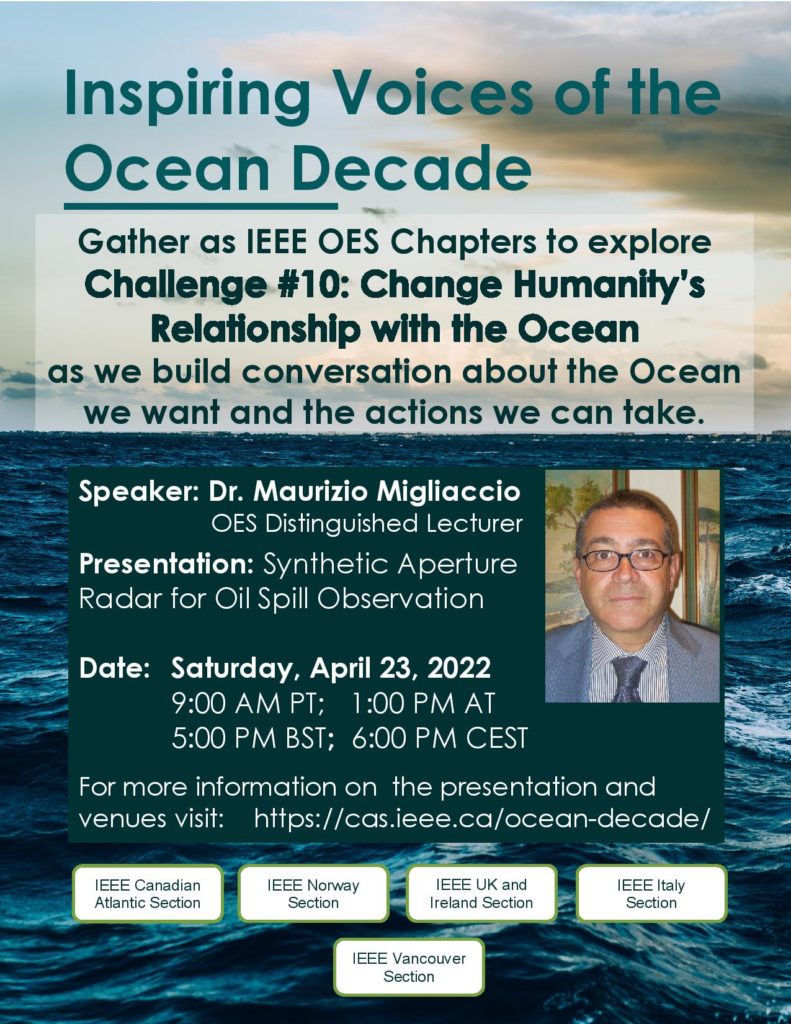
Checkout the UN ocean decade website: https://www.oceandecade.org/
Ocean Decade Challenges for Collective Action:
- Understand and beat marine pollution
- Protect and restore ecosystems and biodiversity
- Sustainably feed the global population
- Develop a sustainable and equitable ocean economy
- Unlock ocean-based solutions to climate change
- Increase community resilience to ocean hazards
- Expand the Global Ocean Observing System (GOOS)
- Create a digital representation of the ocean
- Skills, knowledge and technology for all
- Change humanity’s relationship with the ocean
Challenge 10: Change Humanity’s Relationship with the Ocean – April 23rd, 2022

Please register for the event here
Abstract:
Synthetic Aperture Radar for oil spill observation
Marine oil pollution monitoring is a topic of great applicative and scientific relevance. Use of remotely sensed measurements is of special interest and, in particular, the SAR because of its almost all-weather and all-day imaging capability at fine spatial resolution is the most effective tool. Conventional single-polarization SAR oil spill monitoring techniques are limited in their capability to detect oil slicks since they strongly rely on suitable thresholds, training samples, and ancillary information. Hence, an expert image analyst is due. The launch of a number of polarimetric SAR missions, along with the understanding of the peculiar physical mechanisms governing the scattering by an oil slick, led to a new paradigm (known as physical processing) that fostered a set of polarimetric algorithms particularly robust and efficient. Hence, suitable polarimetric models that exploit the departure from the slick-free sea Bragg scattering have been developed to effectively address oil slick monitoring. A set of polarimetric features extracted following such electromagnetic models have been proved to be reliable for oil slick monitoring. Polarimetric SAR observations led to a significant improvement in sea oil slick observation since they allow distinguishing oil slicks from a broad class of lookalikes in an unsupervised way.
BIO:
Maurizio Migliaccio (M’91-SM’00-F’17) is Full professor of Electromagnetics at Università di Napoli Parthenope (Italy) and was Affiliated Full Professor at NOVA Southeastern University, Fort Lauderdale, FL (USA). He has been teaching Microwave Remote Sensing since 1994. He was visiting scientist at Deutsche Forschungsanstalt fur Lüft und Raumfahrt (DLR), Oberpfaffenhofen, Germany. He was member of the Italian Space Agency (ASI) scientific committee. He was member of the ASI CosmoSkyMed second generation panel. He was e-geos AdCom member. He was Italian delegate of the ESA PB-EO board. He was Member of South Africa Expert Review Panel for Space Exploration. He serves as reviewer for the UE, Italian Research Ministry (MIUR), NCST, Kazakhstan and Hong Kong Research board. He lectured in USA, Canada, Brazil, China, Hong Kong, Germany, Spain, Czech Republic, Switzerland and Italy. He was Italian delegate at UE COST SMOS Mode Action. He is listed in the Italian Top Scientists. He is an IEEE Trans. Geoscience and Remote Sensing AE, International Journal of Remote Sensing AE, and was IEEE Journal of Oceanic Engineering AE Special Issue on Radar for Marine and Maritime Remote Sensing, IEEE JSTARS AE of the Special Issue on CosmoSKyMed, Member of the Indian Journal of Radio & Space Physics Editorial board. His main current scientific interests cover SAR sea oil slick and man-made target monitoring, remote sensing for marine and coastal applications, remote sensing for agriculture monitoring, polarimetry, inverse problems for resolution enhancement, reverberating chambers. He published about 160 peer-reviewed journal papers on remote sensing and applied electromagnetics.
Venues
Each section will be connecting via Zoom, and will host an in-person event at one of the venues listed below. Participants that cannot attend the in-person event can join virtually through Zoom. Please register on here to receive the Zoom link. If there are any questions, please email mae.seto@ieee.org.
Vancouver Section – 9:00 AM PST: TBD
Canadian Atlantic Section – 1:00 PM AST: Dalhousie University: Emera Bldg Romero Classroom (Rm 1004) – right by the main entrance of the Romero Building
Ireland and UK Section – 5:00 PM BST: TBD
Norway Section – 6:00 PM CEST: TBD
Italy Section – 6:00 PM CEST: TBD
====
CAS In-Person attendance:
- You MUST be registered for this event and have notified mae.seto@dal.ca that you are coming in-person. We need to know so we can observe the room limits for distancing.
- Please see the map below for the EMERA Building door entrance to go through and look for the IEEE event flyer on the door. We will also be looking for you.
- The doors of EMERA Rm 1004 will be opened at 12:30 PM ADT.
- Light refreshments will be available at 12:30 PM ADT.
- Attendees will be distanced when seated.
- * * * Dalhousie University requires masking when indoors – except to eat or drink of course. * * *
See you soon.

====
